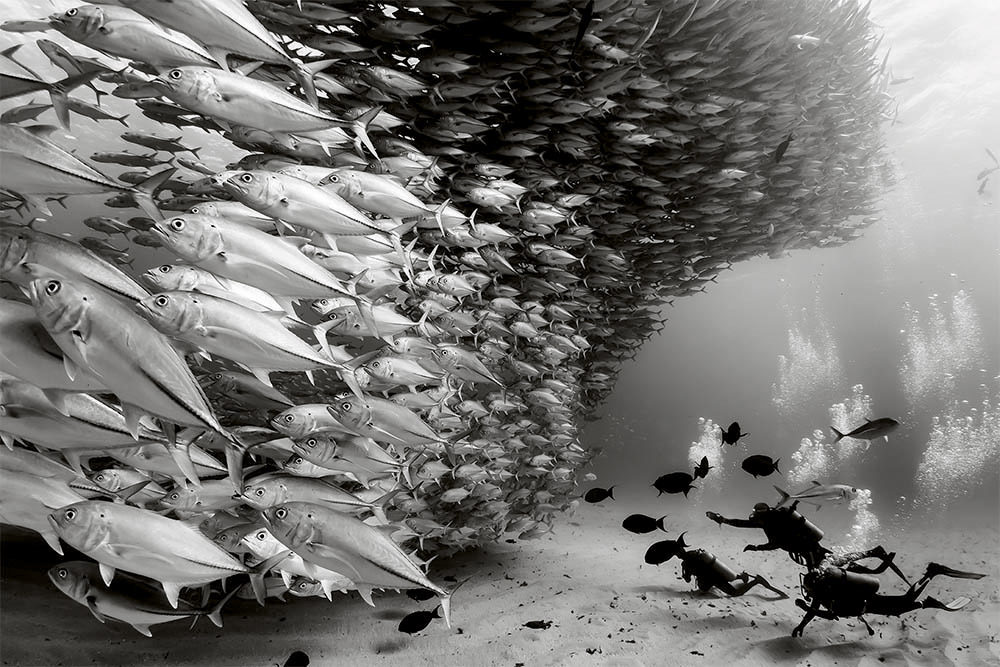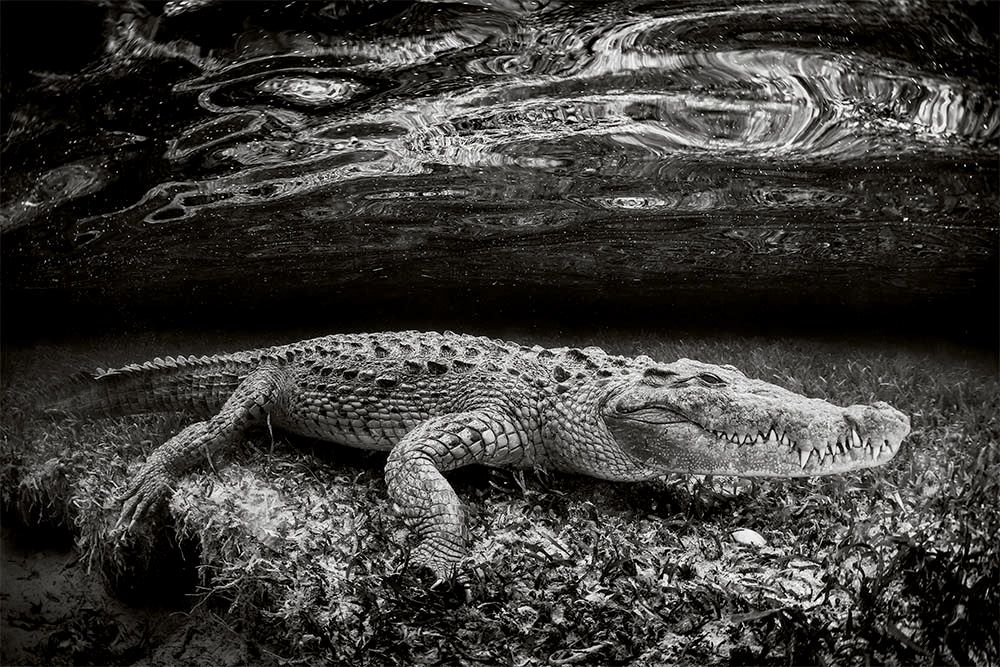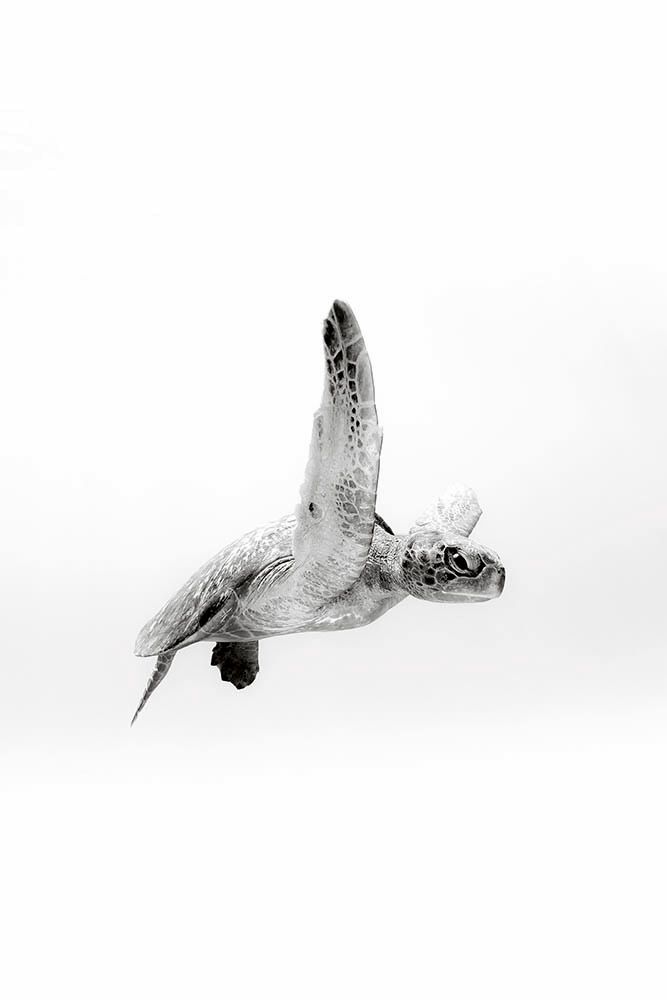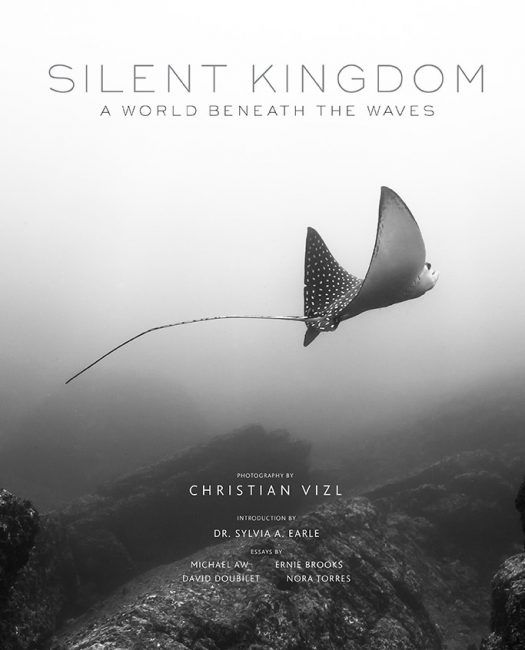blog
Book Review: Silent Kingdom by Christian Vizl

Scuba divers admiring a big school of jacks forming a wall at the protected marine area of Cabo Pulmo, Sea of Cortez, Baja California, Mexico.
It is rare, at least in my experience, that so many (five plus the photographer) contribute texts to a book on photography and so I first go to the book jacket’s inner sleeve to see who they are. Unsurprisingly – we are living in narcissistic times – all of them (with one exception) are described in superlatives, in the case of Silvia Earle even that she was called “Her Deepness” by the New Yorker and the New York Times, “Living Legend” by the Library of Congress, and “Hero of the Planet” by Time magazine (obviously, somebody must have taken this seriously!). Such a display of ego-celebration, I must admit, diminishes my generally positive attitude towards this beautifully done book that is not only convincing in regards to the stunning photographs but also in terms of paper, binding, the arrangement of the pictures on the pages and the book cover that shows an impressive fish swarm.
By the way of fish swarms: Like bird swarms, they make me question our strange belief in competitiveness for to me it looks like they fly and swim respectively and get along together by paying attention to one another and not by following a leader or by competing – a model that I clearly prefer to the fighting model we call competition or even game (football, for instance, ist not a game but a fight, it is rarely characterised by playfulness but by the desire to win at all costs).

A sea turtle and a school of fish swimming above the remains of a shipwreck, Cabo Pulmo, Sea of Cortez, Baja California, Mexico.
“Though the ocean covers more than 70 percent of Planet Earth, over 80 percent of that vast wilderness remains unexplored”, I learn. Photographer Christian Vizl, born in Mexico City, writes in his preface: “Peaceful, still, calm, and excited – this is how I feel when I’m in the ocean, surrounded by its immensity and mysteries. I am in awe of it and grateful for its infinite beauty and abundance of life. The ocean is a world that has so many things to say, so many stories to tell, so many lessons to teach, but its voice can only be heard by our hearts. The images in this book are a reflection of what I hear beneath the waves.”
The black and white images, taken from up-close and from a distance, come thankfully with brief, informative captions, and are truly extraordinary – I often felt like looking at compositions. And, quite some are highly illustrative such as, for example, a free diver champion swimming alongside a shark for it makes clear how huge the shark and how small the swimmer is. The most intriguing pictures I thought to be the various fish swarms – they made me think of bird swarms.

Portrait of an American crocodile resident of the island, Chinchorro, Quintana Roo, Mexico.
In his essay “The Art of Underwater Photography”, Michael Aw points out that underwater photographers are “often taking risks in pursuit of their passion. Working underwater to create masterful images of sharks, coral reefs, dolphins, and whales is not as easy as it might seem. Most cameras are not designed for use in water; expensive housings are required to make them usable. For the underwater photographer, working time is also restricted by nitrogen, which is absorbed into the system when using compressed air under water. When photographers pass the tolerance threshold, they risk decompression sickness, which can be lethal if not treated properly.”
We all know that the underwater world is famously rich with colour, so how come Christian Vizl presents us with a tome in black and white? Sylvia Earle explains that, in this volume, “Vizl insists that we focus on form, texture and rhythm so we can see details lost in the sea’s usual riot of color. His insistence is revealed here in Silent Kingdom through the many subtle shades of silvery grays, stark whites, and sharply defined blacks. As magnificent as colors are, and as skilled as Vizl is at portraying the ocean’s dazzling palette of life, here a rare intimacy is evoked in a misty, dreamlike atmosphere.”

Close-up of a sea turtle swimming ten miles offshore, Ixtapa, Guerrero, Mexico
Reading the texts in this tome was a learning experience for me. I, for instance, had no idea “that the most significant animal migrations do not happen on the land but in the sea as, each night, millions of small fish, plankton, and other animals move up in the water column before descending as the sun rises. This mixes and moves nutrition between deep ocean layers. Still, though, the ocean below one hundred meters is the least explored part of the world, yet covers most of it”, as Sylvia Earle explains.
As much as one might be tempted to think that this is simply another of these exquisite coffee table books, it is (like many other coffee table books, too) much more than that. It is also an attempt at creating awareness for the pollution of the oceans, the decline of marine life and for the fact that biodiversity is a finite resource. “The fact is, we still have enough time the destruction of our planet”, writes Christian Vitzl. Given human nature, however, time is just one the factors and I’m not optimistic. Needless to say, I would of course like to be proven wrong.

Silent Kingdom: A World Beneath The Waves
Photography by Christian Vizl
Introduction by Dr. Silvia A. Earle
Essays by Michael Aw, Ernie Brooks, David Doubilet, Nora Torres
Earth Aware Editions, San Rafael, CA 94912
www.MandalaEarth.com
Location: Online Type: Book Review
Events by Location
Post Categories
Tags
- Abstract
- Alternative process
- Architecture
- Artist Talk
- artistic residency
- Biennial
- Black and White
- Book Fair
- Car culture
- Charity
- Childhood
- Children
- Cities
- Collaboration
- Community
- Cyanotype
- Documentary
- Environment
- Event
- Exhibition
- Faith
- Family
- Fashion
- Festival
- Film Review
- Food
- Friendship
- FStop20th
- Gender
- Gun Culture
- Habitat
- Hom
- home
- journal
- Landscapes
- Lecture
- Love
- Masculinity
- Mental Health
- Migration
- Museums
- Music
- Nature
- Night
- nuclear
- p
- photographic residency
- Photomontage
- Plants
- Podcast
- Portraits
- Prairies
- Religion
- River
- Still Life
- Street Photography
- Tourism
- UFO
- Water
- Zine

Leave a Reply